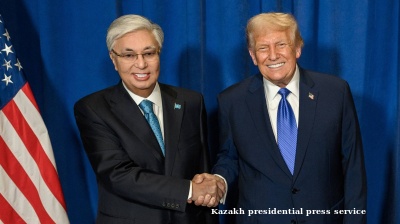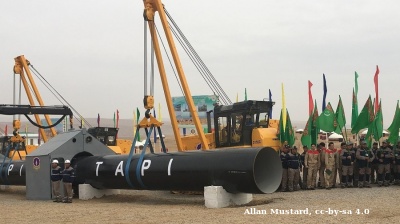China’s engagement with Central Asia has long been framed in sweeping historical terms of caravans, silk, and imperial envoys threading their way between the iconic Xi’an and Samarkand. In modern form, the imagery has become smoother, with high-speed rail, digital corridors and container freight replacing camel trains. Yet the objective remains fundamentally the same: economic connectivity in pursuit of long sought after regional influence.
To this end, Beijing’s most recent trade offensive in Central Asia is both methodical and multi-layered in its blending of physical infrastructure, and political signalling. It is not simply selling goods to resource-rich neighbours seen by much of the rest of Asia as somewhat limited in global outlook; it is rewriting regional supply chains by shaping industrial development and quietly redefining spheres of influence once thought to belong unambiguously to Moscow.
For the five Central Asian republics - Kazakhstan, Kyrgyzstan, Tajikistan, Turkmenistan and Uzbekistan - China has in recent years emerged not only as a dominant trading partner, but increasingly as the only partner nearby that can actually deliver.
Western attention has been episodic. Russia’s capacity has been weakened by war in Ukraine and associated sanctions, and continues to fade away. Beijing meanwhile has stepped in to fill the vacuum with speed, scale and a willingness to tolerate risk on its borders that it avoids at home.
China’s rising trade volumes with the region are significant in themselves, yet it is what lies behind them that matters more. The Belt and Road Initiative (BRI), often caricatured as merely infrastructure diplomacy, has entrenched a new commercial geography. Rail terminals in Khorgos (the biggest dry port in the world according to the South China Morning Post) and Xi’an are no more just logistics hubs; they are instruments of long-term dependency, providing landlocked economies with access to massive Chinese industrial centres on terms Beijing controls.
Cross-border freight trains linking Chongqing and Chengdu to Central Asia and onwards to Europe are thus transforming regional logistics. While maritime routes remain dominant, these rail corridors are politically potent, offering an alternative transit path bypassing Russia altogether. Central Asian officials, used more to doffing their caps to Moscow, are increasingly looking east to Beijing rather than north for economic anchorage.
China’s stance is clear: economic corridors are geopolitical corridors. For Beijing, trade routes are real life arteries through which Communist Party influence and security flow.
Resource extraction, financial dependency
China’s trade with Central Asia is not confined to commodity exchange though. It is increasingly industrial. Beijing is investing in value-added manufacturing zones in Uzbekistan, mining ventures in Kazakhstan, and energy infrastructure in Turkmenistan. The pattern mirrors China’s strategy in parts of Southeast Asia and Africa: embed supply chains and ultimately develop local production that serves Chinese demand by securing raw materials critical to long-term industrial policy back in China – not on its extremities.
Energy, above all, remains central. Turkmen gas supplies China directly through pipelines that reduce reliance on Russian transit. Kazakhstan’s oil exports to China continue to expand, complemented by Chinese yuan being invested in petrochemical facilities.
Lithium, rare earth minerals and copper reserves across the region are attracting Chinese capital and engineering firms, in the process reinforcing Beijing’s role in the global control of critical minerals as has been seen in a recent tiff with the US over access to such.
Central Asian governments are falling for China’s cash-led diplomacy just like many have in Africa. And not doing so, as forward looking as it may be in the long run, is unrealistic. No other major power is offering comparable financing or market access at scale – both of which these five minor economies on the global scale desperately need - none of the five republics coming close to getting into Asia’s top 20 list based on nominal GDP according to the International Monetary Fund’s 2025 figures.
Digital China arrives in Eurasia
An under-appreciated vector of influence Beijing is pushing to the region is digital infrastructure. Chinese telecoms companies have made significant inroads, providing fibre networks, “safe city” surveillance technology and e-government systems. Payments platforms and fintech partnerships are quietly proliferating, tethering Central Asian financial ecosystems to Chinese digital rails.
For Beijing, digital connectivity is a force multiplier. It ensures informational alignment, strengthens political relations and positions Chinese technology standards as default. While European regulation remains an abstract aspiration in the region, Chinese systems are tangible and operational. Concerns of surveillance and / or human rights infringements mean little in much of Central Asia. Because of this, while critics warn of security vulnerabilities and creeping authoritarian influence, supporters - usually those in government - counter that modernisation requires affordable tools and immediate delivery, not lectures.
To this end, China has effectively paired commercial expansion with diplomatic choreography. High-profile summits, regular ministerial dialogues and cross-border cultural forums have become routine, if often meaningless. Where Moscow once presided as patron, Beijing now engages as ‘partner’ on the way to becoming a quasi-patron itself.
Central Asian leaders, seeking to balance Russia’s fading political shadow and Western normative pressures, have in turn found China’s offers appealingly transactional. Beijing speaks the language of ‘mutual benefit’, but rarely raises governance issues, and refrains from explicit security demands beyond stability along its western frontier and cooperation on counter-terrorism.
The losers are the populations of Kazakhstan, Kyrgyzstan, Tajikistan, Turkmenistan and Uzbekistan – roughly 84mn locals whose future is being increasingly linked to Chinese doublespeak.
The relationship being put in place therefore, is not one of equals. Financial leverage breeds political expectation. When Beijing signals displeasure - as was seen when Kyrgyz debt negotiations faltered in 2020, or when Uzbek initiatives have conflicted with BRI priorities in the years since Tashkent joined the BRI in 2015 - responses were swift. They usually emerged in the form of loan deferral pressure and diplomatic statements. Ultimately, trade ties softened diplomacy, but they also sharpened compliance with Beijing’s wishes being followed.
Pragmatism over ideological conversion
To portray Central Asia as falling willingly into China’s embrace, however, oversimplifies a more complex picture. Regional governments are not naive about asymmetric power. They pursue diversification where possible: Kazakhstan actively courts European energy investors; Uzbekistan invites Turkish industrial firms; Turkmenistan periodically flirts with Western gas companies; and Kyrgyzstan even looks to the Gulf for capital; most recently announcing the establishment of a Saudi-Kyrgyz Joint Business Council in May.
But diversification is tactical; Chinese integration is structural. Goods, infrastructure, data and capital – in yuan - increasingly move through Chinese channels. The gravitational pull to the ‘mother ship’ is enduring, and is not driven by sentiment but by practical need.
As a result, while China has not supplanted Russia in Central Asia, yet, it is introducing a new Eurasian order - but not by attempting to replicate Soviet-style dominance. Instead, Beijing’s approach is subtler: build reliance through commerce, embed influence through connectivity, and allow economic logic to mature into strategic alignment. China, as always, is playing the long-game.
For now, Central Asian states hedge carefully, mindful of history and wary of dependence, and losing it. But Beijing is patient. Trade rarely overturns geopolitical realities overnight; it shapes them gradually.
Features

The US now sees China as an equal - it is time for Western media to wake up and do the same
China was long filed under “too foreign, too dangerous, too different” in many Western newsrooms. Not anymore. Beijing is now impossible to ignore as American leaders have realised. Western media outlets need to wake up to this reality too.

Slovenian consumers take energy giant GEN-I to court over price hikes
The Slovene Consumers’ Association accused GEN-I of unlawfully raising household prices at the height of the recent energy crisis.

Indonesia's $12bn stimulus play
The coordination between the Finance Ministry and the presidency signals tighter executive cohesion under President Prabowo’s leadership, contrasting with the cautious fiscal stance of prior administrations.

COMMENT: For Asia, dealing with Europe isn’t about achieving success; it’s about concealing failure
To be taken seriously in Asia, Europe must rediscover the courage to deliver, not merely declare. Asia has moved on to execution. Europe is still editing its initial policy draft.




